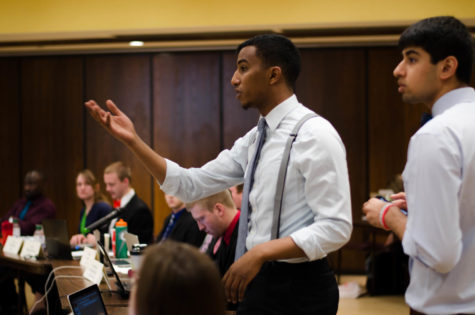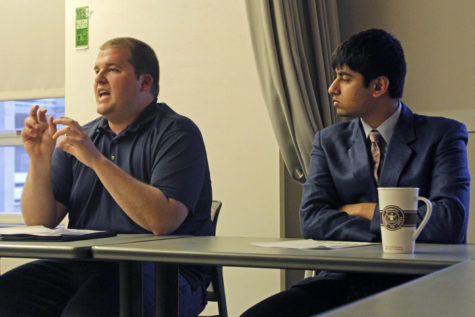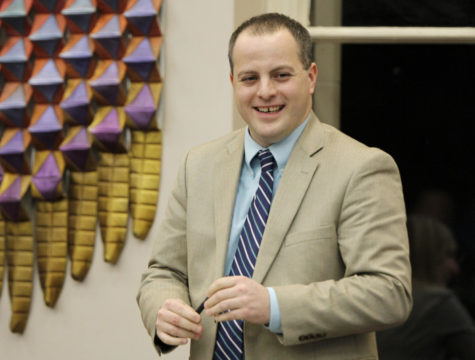GSB, IRHA investigation committee members tour residence halls
October 4, 1999
The Department of Residence is holding up to its end of the bargain by providing information to the recently formed Government of the Student Body/Inter-Residence Hall Association Special Committee on the Department of Residence.
The committee, made up mostly of GSB and IRHA members, began meeting officially on Sept. 14 to investigate the residence department, its budget and the Master Plan.
Director of Residence Randy Alexander took about half of the committee members on a tour Saturday of various residence halls in the three associations as well as Hawthorn Court.
“The kind of living unit we provide does not match today’s students,” Alexander said. “Students want amenities our buildings don’t have.”
The Board of Regents, state of Iowa, approved the Master Plan last year. It entails the destruction and renovation of several residence halls, as well as construction of new apartment and suite-style buildings during the next six years.
“It’s important we move along and take buildings out of service,” Alexander said.
The Towers need a lot of work, he said, particularly Knapp Hall, which is surrounded by a chain-link fence to protect people from chunks of facade falling to the ground.
Built in the early 1970s, the Towers were part of a concept to build high-rise dormitories all over the country.
“The architectural thinking back then was to build these high-rises with every room the same,” Alexander said. “You’d give the students a small little living space, with a commons for activity.”
The design has been a big flop, he said, and many universities around the nation have been tearing similar buildings down.
One of the main problems is students’ not using the commons areas, he said.
The plans for the Towers Residence Association involve changing it from a predominantly freshman area to an upperclassman community.
Wallace and Wilson Halls probably will be renovated, he said, and Knapp and Storms Halls will be torn down and replaced by apartments and town houses.
At this point, the residence department is trying to maintain Knapp and Storms with as little money as possible.
It would cost $7 million to repair Knapp’s facade, an improvement students don’t want to pay for, Alexander said. The temporary fence cost $28,000.
“We don’t collect enough money to maintain the buildings,” he said.
Alexander showed the committee Oak-Elm Hall as an example of an old residence hall that has stayed in good shape.
“Oak-Elm is probably one of our best buildings in terms of condition,” he said.
Alexander said renovating many of the residence halls would not be worth the cost.
“We know that renovating a residence hall does not pay,” he said, which is why most of the plans call for tearing buildings down and rebuilding more modern facilities. “What we actually do will not be what we planned on a few years ago.”
The renovation of Maple Hall cost $14.9 million, Alexander said.
“It would have been cheaper to tear it down and build it over,” he said. It will take 12 years for Maple’s cash flow to break even.
Hawthorn, on the other hand, will generate positive cash flow in the first year it’s open, Alexander said.
“A renovation just doesn’t pay,” he said. The department chose to renovate Maple because of its popular location.
Hawthorn actually cost $1 million less than the department originally planned on paying, Alexander said.
The first nine Hawthorn buildings will be ready for juniors, seniors and graduate students in the fall of 2000, he said. The apartments will hold almost 2,000 students, with very few residence staff members.
“It’s obviously not going to have the same level of student contact as other buildings,” he said.
The Union Drive Association may experience the most changes in the near future.
Helser and Westgate Halls will be torn down, as well as parts of Friley. Three suite-style buildings will be constructed in Helser’s place.
“Anything built in RCA and UDA will be two and three stories, and the architecture will blend in,” Alexander said. “No more high rises.”
Eventually ISU’s residence system will be divided into neighborhoods: UDA and RCA will be for younger students, housing all traditional freshmen; TRA and Hawthorn will hold all upperclassmen and graduate students; Schilletter Village and University Village will be for families only.
Special committee meetings begin
The Government of the Student Body/Inter-Residence Hall Association Special Committee on the Department of Residence has been meeting every Tuesday night at 9 in the Memorial Union.
The members have divided into subcommittees to investigate various aspects of the residence department.
The Student Perspectives Subcommittee, headed by Michel Pogge, GSB, is trying to find out how students feel about the Department of Residence and its spending.
Other members include Brooke Smerber, IRHA, Andy Gruman, GSB, Charles Johnson, GSB, and Jonathon Weaver, GSB.
The Budget Subcommittee, headed by Erin Link, IRHA, is set to examine the residence department’s spending in detail.
They met with Alexander after the tour to discuss department spending with him.
Others members are Dave Eilers, IRHA, Justin Holdridge, IRHA, and Joe Foster, IRHA.
The External Research and Comparisons Subcommittee, headed by Ricky Cordaro, GSB, will examine residence spending at other universities.
Other members are Nathan Ohrt, IRHA, T.J. Schneider, GSB, and Brian Cameron, IRHA.
The Master Plan Subcommittee, headed by Bill Wychulis, IRHA, and Luke DeKoster, GSB, is responsible for knowing as much as possible about the Master Plan. Kyle Jacobsen, IRHA, also is on the committee.
Finally, the Reports Subcommittee, headed by Alex Olson, GSB, will prepare written reports detailing each committee’s progress.
They will be submitted to GSB, IRHA and media outlets each month.
Other members are Kyle Jacobsen, IRHA, and one elected member of each subcommittee.
— Carrie Tett









